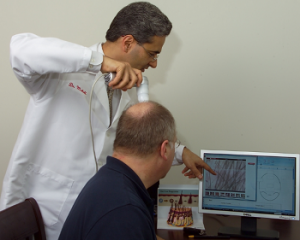Can Magnetic Therapy Stop Hair Loss?
Monday, October 14th, 2013Every now and then there is a new and exotic advertisement going around claiming it can help lessen or stop hair loss. When these advertisements are published in sources that seem reputable, the average consumer may start to believe them. At US Hair Restoration, many of our patients send in questions regarding how real these methods and devices are, and if they should give it a try. In reality however, there are only a few real-world techniques that can actually help hair loss:
- Hair transplantation – the only permanent solution for hair loss. Hair is moved from the permanent zone to the balding area.

- Hair loss medications – Includes medications such as Finasteride and Minoxidil, which can slow down the hair loss process.
- Ketoconazole and Bimatoprost solutions – Two other solutions that appear to stimulate hair growth as one of their side effects.
- Herbel remedies – A few herbal remedies such as saw Palmetto that include DHT blocking properties.
Hair restoration has become a huge market, with over 60% of white males over the age of 50 having experienced some hair loss that requires treatment. By looking at these numbers, it is no wonder why so many of these companies are trying to capitalize on it. As a result, many devices are released, such as LED light hats, laser combs, magnetic devices, heating caps, and so on. Most of them claim that they can benefit the consumer and help hair loss, but these companies are only looking to make a quick dollar. Since they seem harmless and are relatively cheap, consumers are not hesitant to spend money and buy them if it will positively impact their appearance.
Since there are no regulations to put a stop to these types of advertisements, they will always be available on the market. The best advice is to seek a skilled hair transplant surgeon and disregard the other gimmicks.


 Hair goes through a cycling phase, where a hair shaft falls and after a few weeks another one begins to grow from the same follicle. In most cases the cycle won’t pass 20% of the hair shafts in any area. Hair loss will become active because the follicles of the hair go through a growth cycle. During the growth cycle process, there are resting intervals where the hairs slowly start to get thinner and miniaturization occurs. Only a small percentage of the hairs will be in resting phase. Miniaturization occurs when the hair shaft is no longer as thick as it was before. At that time the hairs become very thin and it is not seen to the naked eye.
Hair goes through a cycling phase, where a hair shaft falls and after a few weeks another one begins to grow from the same follicle. In most cases the cycle won’t pass 20% of the hair shafts in any area. Hair loss will become active because the follicles of the hair go through a growth cycle. During the growth cycle process, there are resting intervals where the hairs slowly start to get thinner and miniaturization occurs. Only a small percentage of the hairs will be in resting phase. Miniaturization occurs when the hair shaft is no longer as thick as it was before. At that time the hairs become very thin and it is not seen to the naked eye.